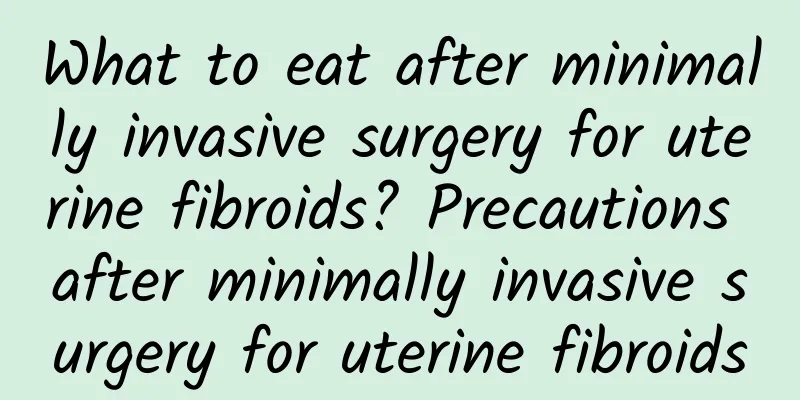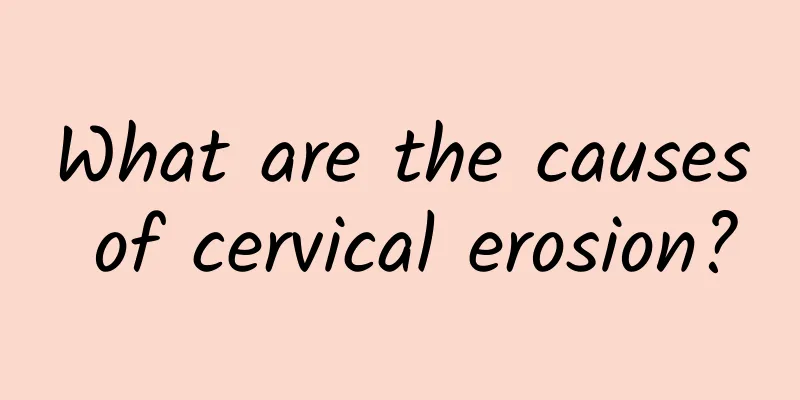What to eat after minimally invasive surgery for uterine fibroids? Precautions after minimally invasive surgery for uterine fibroids

|
The main things to note after minimally invasive surgery for uterine fibroids are: 1. Carefully take care of the surgical wound: After uterine fibroid surgery, the patient's surgical wound is usually at the navel, about 1 cm long. Keep the wound clean and dry after surgery, and do not scratch the wound at will. The wound usually heals ten days after surgery. During this period, avoid getting the wound wet by showering. 2. Develop regular daily living habits: After uterine fibroid surgery, patients need to get enough rest and eat a light diet to help with recovery. If the recovery is good, patients can resume their normal work and rest routine within 7 days after surgery. Patients who like to stay up late and have irregular work and rest routines should be strict with themselves after surgery and develop a healthy and reasonable work and rest schedule for themselves. 3. Moderate exercise: Usually patients recover well 50 days after uterine fibroid surgery. According to their physical condition, they can choose the right exercise for themselves in a targeted manner, and insist on exercising to help improve their physical fitness. Diet after minimally invasive surgery for uterine fibroids should also be taken care of. For example, patients with uterine fibroids should eat light food, and it is best not to eat mutton, dog meat, shrimp, crab, eel, salted fish, black fish and other hair. Patients with uterine fibroids can eat more seaweed foods, such as seaweed, kelp, cabbage, wakame vegetables, etc. Seaweed contains the most calcium, iron, sodium, magnesium, phosphorus, iodine and other minerals. Modern science believes that regular consumption of seaweed foods can effectively regulate blood pH and avoid acid neutralization and excessive consumption of alkaline elements (calcium, zinc) in the body. Keep low-fat tea and rice, and eat more lean meat, chicken, eggs, quail eggs, crucian carp, turtle, white fish, cabbage, asparagus, celery, spinach, cucumber, winter melon, mushrooms, tofu, kelp, seaweed, fruits and other cold dishes and fruits. What kind of diet should be taken after minimally invasive surgery for uterine fibroids? Which foods are more suitable for recovery? Patients with uterine fibroids should eat light meals and it is best not to eat irritating foods such as mutton, dog meat, shrimp, crab, eel, salted fish, and black fish. 2. Patients with uterine fibroids should eat more whole grains such as corn and beans, and can also often eat some nutritious dried fruits such as peanuts, sesame seeds, melon seeds, etc. In addition, daily tea and rice should be quantified on time to prevent overeating. 3. Eat more lean meat, chicken, eggs, quail eggs, crucian carp, turtle, white fish, cabbage, asparagus, celery, spinach, cucumber, winter melon, mushrooms, tofu, kelp, seaweed, fruits and other cold dishes and fruits. 4. Patients with uterine fibroids can eat more seaweed foods, such as laver, kelp, sea cabbage, wakame, etc. Seaweed contains the most minerals such as calcium, iron, sodium, magnesium, phosphorus, iodine, etc. Modern science believes that eating seaweed foods regularly can effectively regulate the pH of the blood and avoid excessive consumption of alkaline elements (calcium and zinc) in the body due to acid neutralization. How long you need to rest after uterine fibroid surgery varies. Because traditional uterine fibroid surgery is harmful to women's bodies, you need to rest for a long time after surgery to recover. Traditional uterine fibroid surgery requires at least two weeks of rest. Full recovery takes two to three months. For patients who choose minimally invasive surgery to treat uterine fibroids, they usually stay in the hospital for 2-3 days, rest for 1-2 weeks, and fully recover in about 1-2 months. The specific rest method after uterine fibroid surgery is related to the patient's physical condition. |
Recommend
Ectopic pregnancy may be caused by a tumor in the pelvis
Ectopic pregnancy may be caused by a tumor in the...
Common symptoms of uterine fibroids that you need to know
There are always some signs in the early stages o...
When does uterine fibroids require surgery? Surgical treatment of uterine fibroids
How many surgeries are needed for uterine fibroid...
Women should be aware that delayed menstruation may be a sign of menstrual irregularity
Irregular menstruation is the most common female ...
What medicine to take for irregular menstruation? These 6 medicines are better for irregular menstruation
Irregular menstruation is a common condition and ...
What are the common misunderstandings in the treatment of adnexitis?
What are the misunderstandings in the treatment o...
Understand the possible side effects before liposuction surgery
Modern people value efficiency at work, and this ...
What are the symptoms of cervical erosion in women? How to treat cervical erosion in women?
Symptoms of cervical erosion After suffering from...
Are the symptoms of pregnancy and uterine fibroids similar?
Are the early symptoms of pregnancy similar to th...
Ovulation test paper will show weak positive before menstruation
Since people have little knowledge of testing, th...
Is it better to take Jingangteng or Gynecological Qianjin Tablets for pelvic inflammatory disease?
Is it better to take King Kong Teng or Gynecologi...
How to use medicine for pelvic inflammatory disease
How to use medicine for pelvic inflammatory disea...
What causes adnexitis?
Treatment of adnexitis includes antibiotics, phys...
What causes bilateral ovarian cysts? How to treat them?
What causes bilateral ovarian cysts? How to treat...
Red food is in short supply, eat seasonal fruits first
In the cold wind, eating more red foods can enhan...









